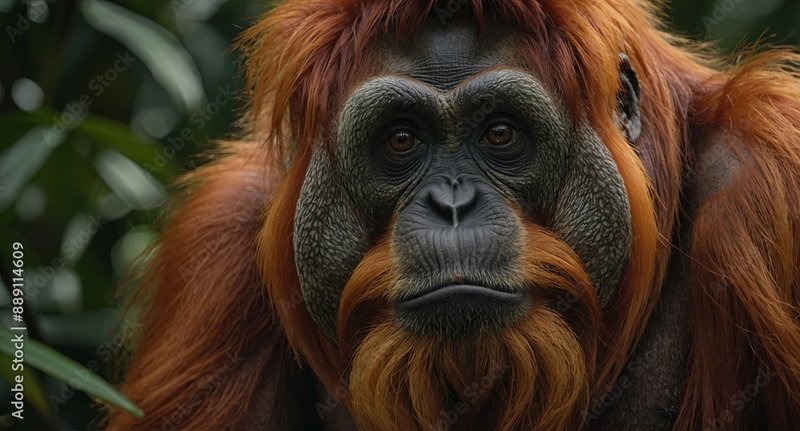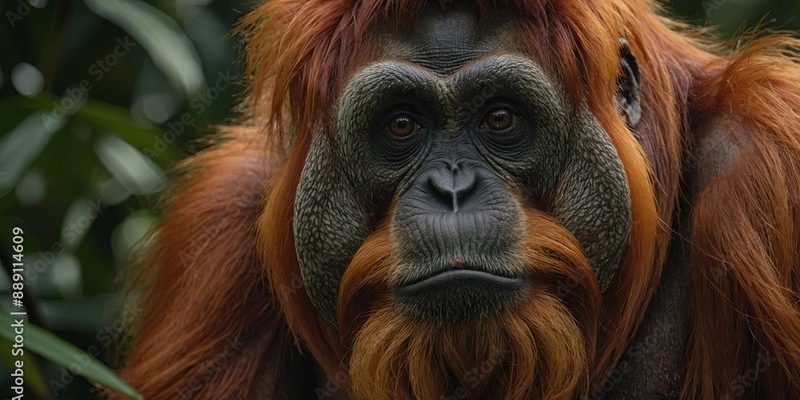
Orangutans are some of the most fascinating creatures on our planet. Imagine a creature that shares almost 97% of its DNA with you! Yes, that’s right—orangutans are our closest relatives in the animal kingdom, sharing many genetic similarities with humans. But they are not just remarkable because of their DNA; they are incredible beings with unique behaviors and adaptations that have evolved over millions of years.
These gentle giants live primarily in the lush rainforests of Borneo and Sumatra. Their striking orange fur and expressive faces make them instantly recognizable. You might think of orangutans as being similar to humans, but they have a life full of surprises and struggles, especially when it comes to their habitat and survival. So, let’s dive deeper and learn more about these amazing animals!
Physical Characteristics
Orangutans are known for their remarkable physical features. They are large primates, typically weighing between 100 to 200 pounds, with males being significantly larger than females. Their long, lanky arms can stretch out to about 7 feet, making them adept at swinging through the trees. If you’ve ever seen a monkey move, imagine that, but mix in a more deliberate and graceful style—like an acrobat in a slow-motion performance.
One of their most striking characteristics is their fur. The vibrant orange coloration helps them blend into the dappled sunlight of their rainforest homes, providing both camouflage and protection. Their facial features are also captivating; they have expressive eyes that can convey emotions and thoughts, and their strong jaws and cheek pads give male orangutans a distinctive look as they mature.
But it’s not just their appearance that’s interesting. Their hands and feet are perfectly adapted for their arboreal lifestyle. With long fingers and opposable thumbs, they can grasp branches securely, allowing them to navigate the treetops with ease. Just picture an expert climber making their way up a tree while carrying a snack in one hand!
Habitat and Distribution
Orangutans primarily inhabit the tropical rainforests of Borneo and Sumatra. These lush environments provide everything they need: food, shelter, and a place to raise their young. Unfortunately, their habitat is under serious threat. Deforestation for palm oil production and logging has drastically reduced the areas where orangutans can live.
These remarkable animals spend most of their time in trees, where they create platforms to rest and sleep. They are known as arboreal primates, which means they are adapted to live in the trees rather than on the ground. Imagine living in a high-rise apartment made of branches, where every day is a new adventure just a few tree limbs away!
When exploring their habitat, it’s essential to understand that orangutans are solitary creatures. Their social structure is quite different from other primates. While they do interact with one another, especially mothers with their young, they typically prefer to have their “personal space.” This makes their rainforest homes even more critical for their comfort and safety.
Diet and Feeding Habits
You might be surprised to learn that orangutans are primarily frugivores, which means they love to eat fruit! They consume a wide variety of fruits, including durian, figs, and mangoes. Their strong jaws and teeth help them crack open tough shells, making it easier to access the sweet, nutritious flesh inside. Think of them as the gourmet chefs of the rainforest, carefully selecting their meals to ensure a delightful dining experience.
In addition to fruit, orangutans also eat leaves, bark, and flowers. They are known to use tools as well, such as sticks to extract insects or honey from tree hollows. This ability to use tools is a sign of their intelligence and adaptability. Picture a curious child experimenting with different tools to reach a cookie jar—that’s the same kind of resourcefulness orangutans exhibit!
This omnivorous diet plays a vital role in their ecosystem. As they consume fruits and move through the forest, they help disperse seeds, which promotes new plant growth. So, they’re not just eating; they’re actively contributing to the health of their environment. How’s that for being a responsible member of the community?
Behavior and Social Structure
Orangutans exhibit a wide range of behaviors, many of which reflect their intelligence. In the wild, they are known for being quite curious and observant. They often spend hours watching other animals and their surroundings. This observational nature helps them learn about potential threats and food sources. You could say they’re the introverts of the animal kingdom—thoughtful and cautious about their environment.
When it comes to social structure, orangutans are generally solitary creatures. Adult females typically take care of their young for several years, teaching them essential skills needed for survival. In contrast, males often establish their territories and may not interact much with others unless it’s mating season. It can be likened to a quiet neighbor who keeps to themselves, only emerging to socialize during special occasions.
Despite their solitary nature, orangutans do form connections. Mothers and babies have a strong bond, and the young ones learn vital survival skills from their mothers. Imagine a mother teaching her child how to climb or find food, guiding them through the lush green playground that is their home. This nurturing aspect of orangutan behavior is one of the many reasons they are so endearing to us!
Conservation Status
Unfortunately, orangutans are classified as critically endangered, with their populations dwindling due to habitat loss and poaching. The destruction of their rainforest homes is primarily driven by industrial activities, such as logging and palm oil plantations. As these forests disappear, so do the lives and futures of these magnificent creatures. It’s a heartbreaking reality that has serious implications not just for orangutans, but for the entire ecosystem.
Conservation efforts are underway, aimed at protecting their habitats and raising awareness about the importance of saving these incredible animals. Organizations are working tirelessly to combat deforestation, establish wildlife reserves, and support rehabilitation programs for orphaned orangutans. It’s like a community coming together to save a cherished local treasure—a concerted effort to ensure that orangutans have a fighting chance for survival.
As individuals, we can also contribute to these efforts. By choosing products that are sustainably sourced and being mindful of our consumption habits, we can help create a future where orangutans thrive in their natural habitats. It’s a collective responsibility we all share, and every small action counts. Imagine if we all made a simple change—together, we could create a wave of positive impact!
Interesting Facts
| Scientific Name: | Pongo pygmaeus (Bornean orangutan), Pongo abelii (Sumatran orangutan) |
| Lifespan: | 30 to 40 years in the wild, up to 60 years in captivity |
| Weight: | 100 to 200 pounds |
| Diet: | Fruits, leaves, bark, and occasionally insects |
| Habitat: | Tropical rainforests in Borneo and Sumatra |
| Social Structure: | Mostly solitary, with mothers caring for their young |
FAQ
What are the main threats to orangutans?
Orangutans face several threats, the most significant being habitat destruction due to deforestation. Palm oil production is a major driver of this issue, as vast areas of rainforest are cleared to make way for plantations. Additionally, poaching and illegal wildlife trade pose direct dangers to orangutans, further diminishing their populations.
How can I help orangutans?
Supporting conservation organizations dedicated to orangutan protection is a fantastic way to help. You can also make informed choices about products you buy, prioritizing sustainably sourced palm oil and supporting companies with ethical practices. Educating others about the plight of orangutans can also raise awareness and encourage collective action.
Do orangutans live in groups?
Typically, orangutans are solitary animals. While females tend to stay with their young, adult males usually live alone and establish their territories. However, they do occasionally come together during mating season or when food sources are abundant. This solitary behavior is a unique aspect of their social structure.
How smart are orangutans compared to other primates?
Orangutans are considered highly intelligent, with cognitive abilities that can rival those of chimpanzees. They are known for their problem-solving skills and ability to use tools, which demonstrates their advanced intelligence. Their capacity for learning and adapting makes them one of the most mentally equipped primates.
How long do orangutans stay with their mothers?
Young orangutans typically stay with their mothers for about 6 to 8 years. During this time, mothers teach them essential survival skills such as finding food and navigating the trees. After this period, the young ones become increasingly independent but will still visit their mothers occasionally.
Are orangutans endangered?
Yes, orangutans are classified as critically endangered. Their populations are rapidly declining due to habitat loss, primarily from deforestation and the illegal wildlife trade. Ongoing conservation efforts are critical to ensuring their survival for future generations.
What is the average lifespan of an orangutan?
In the wild, orangutans can live around 30 to 40 years, while those in captivity may live up to 60 years or more due to better medical care and absence of threats. Their lifespan can be influenced by environmental factors and human impact on their habitat.
Can orangutans swim?
While orangutans are primarily arboreal and prefer to stay in trees, they are capable swimmers. They can cross rivers or streams when necessary, even using their long arms to paddle through the water. This swimming ability allows them to access new areas of their habitat when needed.
How do orangutans communicate?
Orangutans communicate using a variety of vocalizations, gestures, and facial expressions. They can make distinct sounds to signal warnings, express excitement, or find a mate. Their communication is complex and reflects their intelligence, often conveying emotions and intentions effectively.
What role do orangutans play in their ecosystem?
Orangutans play a vital role as seed dispersers in their rainforest habitats. By consuming fruits and moving through the trees, they help promote new plant growth. Their presence contributes to the overall health of the ecosystem, supporting a diverse range of plant and animal life.

